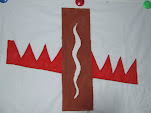Changing the Sun’s Sex
©
As unusual as it may seem, the arrival of Aztec
rule over the Toltecs in Meso America ,
resembles the rivalry of Western neo-Christianity with Eastern Christianity and
ultimately the destruction of the East in Europe .
While specifics differ, the general trend goes along parallel tracks.
At this time there is no direct historical evidence
that either neo-Christians had come to the Toltecs earlier than the Spanish
conquistador Cortez, or that the Toltecs had crossed the Atlantic and arrived
in Europe as museum specimens some centuries before we are told they did, and then
returned home to tell their people to expect the arrival of a God they called
Quetzalcoatl http://en.wikipedia.org/wiki/Quetzalcoatl
, also known as the plumed serpent.
The above link, if one reads it from end to end,
does in fact suggest possible early contacts of the Maya people with Europe and
Mediterranean cultures. For one, Quetzalcoatl
was also known by the name of Kukulcan. The letter ‘c’ in Kukulcan may be replaced by the letter ‘h’, therefore,
Kukulhan may have been pronounced Kukulyan, because the letter ‘h’ is either
silent or because it precedes a vowel, ‘u’, which is then preceded by an
unvocalized ‘i’ or ‘’j. Therefore, ‘coatl’ may also have been pronounced
‘yonatl’, which relates the word to the European Johann (German), Huan
(Spanish), even Greek Dionysus. Of course, these associations are speculations,
but once made, they cannot be discarded as making no sense. If ‘quet’ stands
for feather and ‘zal’ stands for ‘St. ’, then
what we get is Feathered St
Pareidolic leaps of fantasy indeed often justify themselves with discoveries
of previously unknown variations on stories heretofore known as having only one
variant. Skeptics may rail against pareidolia, but then a skeptic is hard-wired
mathematician, who has no connection with poetry or the braiding of words,
which use associations no less logically.
One unremembered association of the Sun over Mexico
Though ‘Sparknotes’ gives avery different explanation for the events than I
do, on closer examination, the story as told by Euripides easily emerges as one
that is both secretive and coded. My retelling of it provides a more
understandable reason for why the secretiveness and what the actual event is
about. There was, in fact, something in its content to keep hid.
“The Bacchae”, like the story in Mexico
The Theban ruler Pentheus [said to be the grandson of Cadmus http://www.sparknotes.com/drama/bacchae/summary.html,
who had founded Thebes Thebes
The Sun was in profound disagreement with her separation from her creation
and removal from a position of authority. She sent King Pentheus numerous
warnings by sending him disturbing dreams of the consequences of the rule of
law http://papers.ssrn.com/sol3/papers.cfm?abstract_id=1780584
. In one dream King Pentheus saw himself as a shepherd over a herd that had
been turned into stone. When the King tried to move one of the eves by poking her
with a branch, the sheep’s stone wool turned blood red as if she had been skinned
alive. When the wives of the King herd of his plans, they took to washing off their
menstrual blood in the bathhouse, where the bath was used to wash sheep’s wool.
When none of the warnings had any effect, the Sun sent Dionysus, a disowned son
of Semele (earth), to Thebes
Since the chronology of Western historians is entirely fanciful and generally
agrees with neo-Christian prejudices, we do not know when these events in Greece
When Dionysus came to Thebes Thebes
Dionysus, however, persuaded the maenads to continue their feasting, but
also invite the men of Thebes
Thus, the orgy of drinking and sexual petting went on almost until sunrise.
Dionysus invited the women to spread a rumor that the party was going to
continue the next day and if the men were too tired to join, the maenads would
take on all donkeys and billy goats in town. The King was told that this was
something to see.
The King then sent his men to spy out the ritual grounds (the usual place
such events were held) on Mt.
Cithaeron
The King’s men, of course, reported to King Pentheus what they had seen.
The King immediately decided to act the hero and go to the Sun’s rescue. As it
turned out, it was not to be as easy a rescue as Pentheus had imagined it would
be.
The King had gone only a little way up the mountain from his castle, when
Dionysus and all the sleeping maenads were awakened by an incessant crowing of
the roosters, braying of donkeys, and bleating of billy goats. The animals had
noticed, too, that something was wrong with the daylight. The rays of the Sun
barely crossed the tops of trees, and the morning light continued in place as it
had never done before. Dionysus and the maenads immediately started back up Mt. Cithaeron
“Pass me my trident,” said King Pentheus to one of his guards.
“I will see if I can poke that mother lose.”

No comments:
Post a Comment